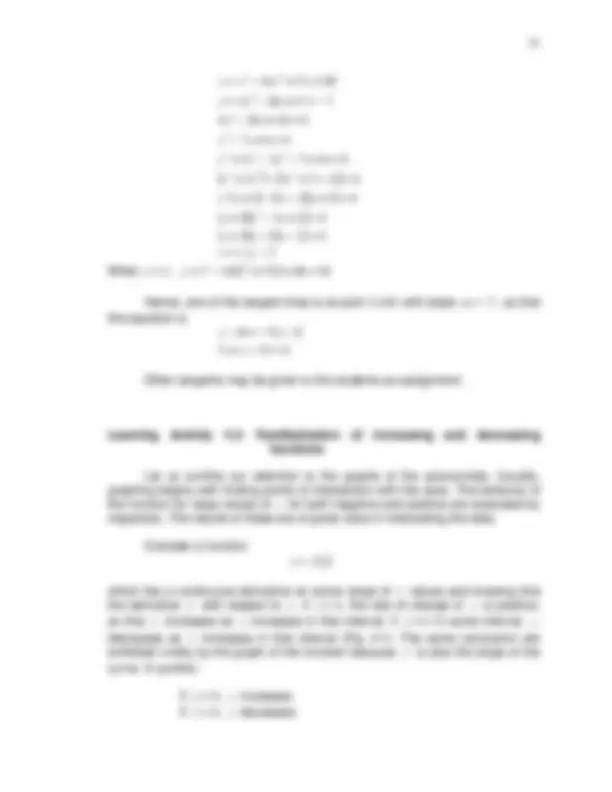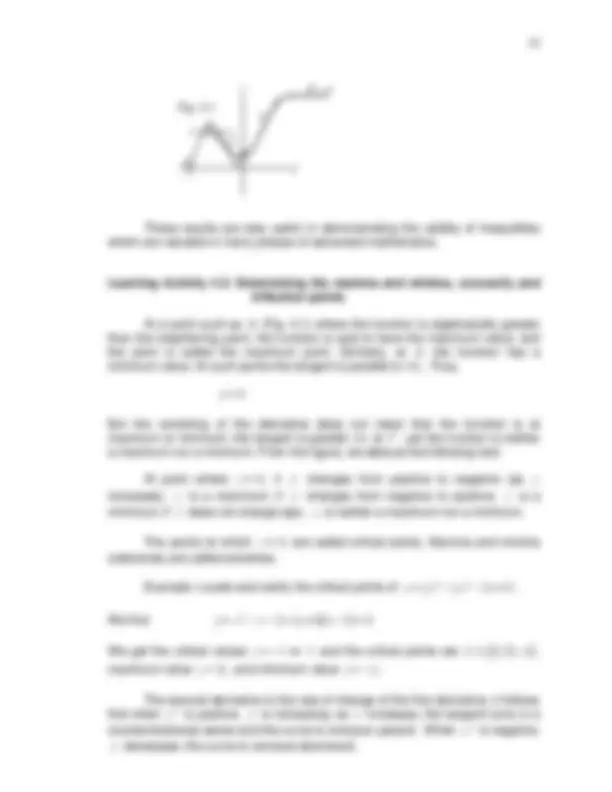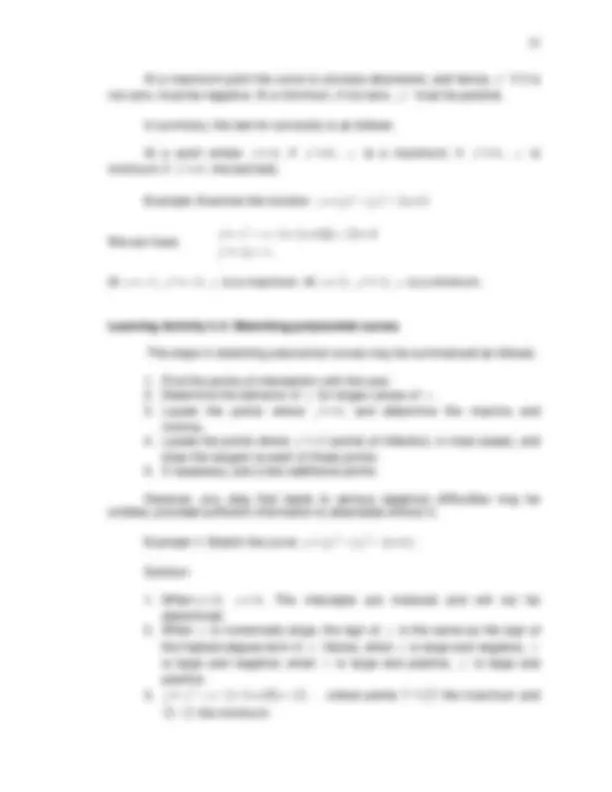





Study with the several resources on Docsity

Earn points by helping other students or get them with a premium plan


Prepare for your exams
Study with the several resources on Docsity

Earn points to download
Earn points by helping other students or get them with a premium plan
Community
Ask the community for help and clear up your study doubts
Discover the best universities in your country according to Docsity users
Free resources
Download our free guides on studying techniques, anxiety management strategies, and thesis advice from Docsity tutors
Instructions and examples on how to find tangents, normal lines, maxima, minima, inflection points and the behavior of increasing and decreasing functions for plane polynomial curves. It includes the use of equations and graphs to illustrate the concepts.
Typology: Quizzes
1 / 6

This page cannot be seen from the preview
Don't miss anything!




Unit 4 – Polynomial Curves
General Objective:
At the end of the unit, the student should be able to differentiate polynomial curves.
Specific Objectives:
At the end of the unit, the student is expected to:
Content:
Learning Activity 4.1: Determining tangents and normal to plane curves
Hence, to find the tangent at any point of a plane curve we have to find the slope of the curve at that point, and substitute for m in the above formula.
that point and perpendicular to the tangent line. The equation of this normal can be found by recalling that the slope of it is the negative reciprocal of the slope of the tangent.
Example 1: Find the equations of the tangent and normal to the curve
then
y m x
y x x
x y
y x
Then, use 4
m 1 m to have the equation of the normal:
x y
y x
Example 2: Find the tangents to the ellipse x^2 4 y^2 8 parallel to the line x 2 y 6.
Solution: Solving for the slope of the given line and then obtain for the derivative of the ellipse and determine the points of tangency. Thus, we get
2
1
2
m
y x
x y
x y
x y
x yy
x y
2
1
2 2
The points on the ellipse where the tangents have slope of 21 can be
determined by substituting x 2 y to the equation of the given ellipse. This is
shown as follows:
(^22)
2 2
x y
y
y y
x y
Equation of the tangents:
Example 3: Find the tangents to the curve y x^4 14 x^2 17 x 40
perpendicular to the line x 7 y 4.
Solution: x 7 y 4 ; 7
m 1 ; m 7
These results are also useful in demonstrating the validity of inequalities which are valuable in many phases of advanced mathematics.
Learning Activity 4.3: Determining the maxima and minima, concavity and inflection points
At a point such as B (Fig. 4.1) where the function is algebraically greater than the neighboring point, the function is said to have the maximum value, and the point is called the maximum point. Similarly, at D the function has a minimum value. At such points the tangent is parallel to Ox. Thus,
y ' 0
But the vanishing of the derivative does not mean that the function is at maximum or minimum; the tangent is parallel Ox at F , yet the function is neither a maximum nor a minimum. From the figure, we deduce the following test:
At point where y ' 0 , if y ' changes from positive to negative (as x
increases), y is a maximum; if y ' changes from negative to positive, y is a
minimum; if y ' does not change sign, y is neither a maximum nor a minimum.
The points at which y ' 0 are called critical points. Maxima and minima
collectively are called extremes.
Example: Locate and clarify the critical points of y 31 x^3 21 x^2 2 x 2.
We get the critical values x 1 or 2 and the critical points are 1 , 196 , 2 , 34 ,
maximum value y ^196 , and minimum value y 34.
The second derivative is the rate of change of the first derivative. it follows that when y '' is positive, y ' is increasing; as x increases, the tangent turns in a
counterclockwise sense and the curve is concave upward. When y ''is negative,
y ' decreases; the curve is concave downward.
Fig. 4.
At a maximum point the curve is concave downward, and hence y '' if it is
not zero, must be negative. At a minimum, if not zero, (^) y '' must be positive.
In summary, the test for concavity is as follows:
At a point where y ' 0 , if y ' ' 0 , y is a maximum; if y '' 0 , y is
minimum; if y ' ' 0 , the test fails.
Example: Examine the function y 31 x^3 21 x^2 2 x 2
We can have
y x
y x x x x
At x 1 , y ' ' 3 ; y is a maximum. At x 2 , y ' ' 3 ; y is a minimum.
Learning Activity 4.4: Sketching polynomial curves
The steps in sketching polynomial curves may be summarized as follows:
However, any step that leads to serious algebraic difficulties may be omitted, provided sufficient information is obtainable without it.
Example 1: Sketch the curve y 13 x^3 21 x^2 2 x 2.
Solution: